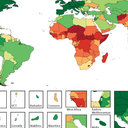Clinicoimmunologic studies on Phoenix sylvestris Roxb. pollen: an aeroallergen from Calcutta, India.
Ключевые слова
абстрактный
BACKGROUND
This study highlights the allergenicity and allergenic components of the pollen of Phoenix sylvestris Roxb. (PS), or date sugar palm, which is predominantly airborne in the air of Greater Calcutta.
METHODS
A 2-year aerobiologic survey was performed by Burkard sampler. PS pollen extract was used in skin tests of allergic patients, fractionated by (NH4)2SO4 and the Sephacryl S-200 column. The allergenicity of each fraction was checked by skin test and IgE ELISA inhibition. The principal allergenic fraction, Fr.lla, was separated in 11% SDS-PAGE, and its allergenicity was confirmed by IgE ELISA inhibition and immunoblotting.
RESULTS
PS pollen grains were found to be prevalent in the air of the suburban zone of Calcutta from January to March with a peak in February. The pollen extract showed high (44.07%) positive skin reaction on 540 respiratory allergic patients. Among the (NH4)2SO4 cut fractions, Fr.II was the most active one, and it was resolved into four subfractions in the Sephacryl S-200 column. Fr.lla was the principal allergenic fraction, showing the presence of two components of 33 and 66 kDa in SDS-PAGE. In IgE immunoblotting, both of the components were found to be allergenic.
CONCLUSIONS
The PS pollen grain is an important aeroallergen from Calcutta, India. The 33- and 66-kDa components are the major allergens present in the relevant pollen extract.


